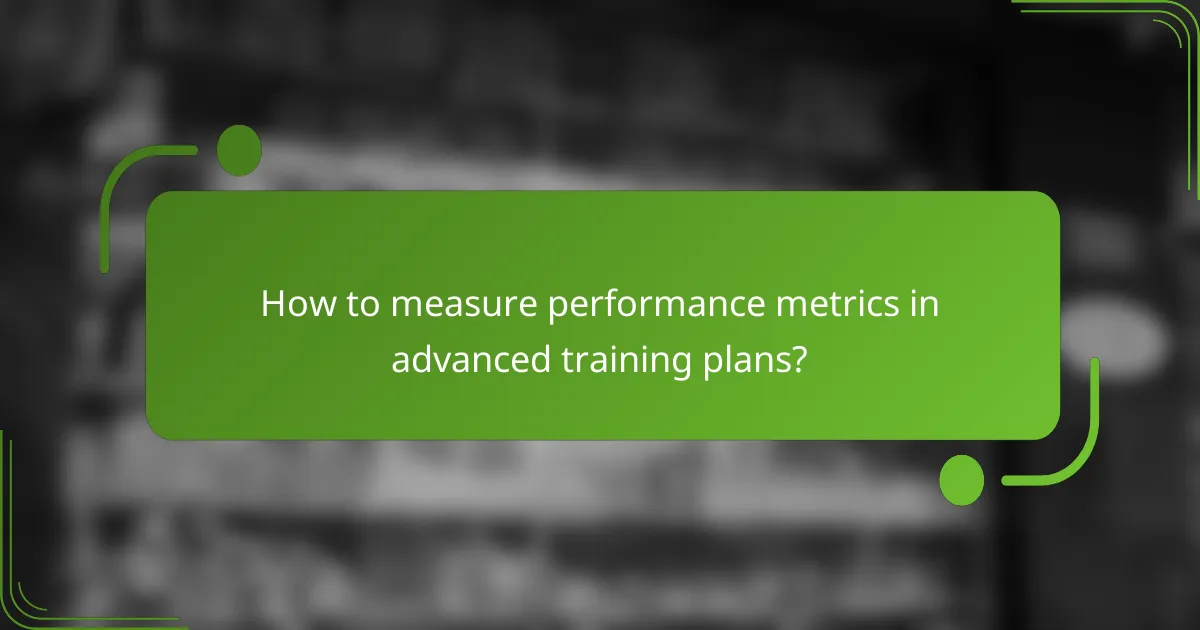An advanced training plan is essential for athletes aiming to optimize their performance through careful measurement of key metrics. By aligning competitive aspirations with individual capabilities, athletes can maintain motivation and focus in their training. Additionally, addressing recovery needs is crucial for enhancing performance and minimizing injury risk, ensuring that athletes are well-prepared for future challenges.

How to measure performance metrics in advanced training plans?
Measuring performance metrics in advanced training plans involves tracking specific indicators that reflect an athlete’s progress and effectiveness. This process helps identify strengths and weaknesses, guiding adjustments to training for optimal results.
Key performance indicators (KPIs)
Key performance indicators (KPIs) are essential metrics that gauge an athlete’s progress in training. Common KPIs include speed, endurance, strength, and recovery times, which can be quantified through various tests and assessments.
For instance, tracking sprint times over a set distance can reveal improvements in speed, while monitoring heart rate recovery post-exercise can indicate cardiovascular fitness. Establishing baseline measurements and regularly comparing them helps in assessing progress.
Data tracking tools
Data tracking tools are vital for collecting and analyzing performance metrics. Wearable devices, such as fitness trackers and smartwatches, can provide real-time data on heart rate, distance, and calories burned.
Additionally, software applications can help compile and analyze data, offering insights into trends and patterns. Popular options include platforms like Strava or TrainingPeaks, which allow athletes to log workouts and monitor their performance over time.
Benchmarking against competitors
Benchmarking against competitors involves comparing your performance metrics with those of similar athletes or teams. This practice helps set realistic goals and identify areas for improvement.
To effectively benchmark, gather data from competitions or training sessions and analyze how your metrics stack up against others in your category. This can include comparing race times, lifting weights, or endurance levels, providing a clear picture of where you stand in your competitive landscape.

What competitive aspirations should be set?
Competitive aspirations should be specific, measurable, and aligned with both individual capabilities and broader goals. These aspirations help guide training focus and performance metrics, ensuring athletes stay motivated and on track.
Identifying top competitors
To set competitive aspirations, first identify the top competitors in your field. Analyze their strengths, weaknesses, and performance metrics to understand where you stand. This comparison can help you pinpoint areas for improvement and set realistic benchmarks.
Consider factors such as recent competition results, rankings, and performance trends. Tools like athlete databases or competition reports can provide valuable insights into competitor profiles.
Setting realistic performance goals
Realistic performance goals should be based on both current capabilities and the benchmarks established from competitor analysis. Aim for goals that challenge you but remain achievable, such as improving your time by a few seconds or increasing your endurance by a certain percentage.
Utilize the SMART criteria—Specific, Measurable, Achievable, Relevant, Time-bound—to structure your goals effectively. For example, instead of saying “I want to run faster,” specify “I want to reduce my 5K time by 2 minutes within three months.”
Aligning aspirations with training outcomes
Your competitive aspirations must align with your training outcomes to ensure progress. Regularly assess your training regimen to see if it effectively supports your goals. Adjustments may be necessary if you find that your training is not translating into improved performance.
Incorporate performance metrics such as speed, endurance, and recovery times into your training evaluations. This data-driven approach allows you to make informed decisions about your training plan and helps maintain motivation as you track your progress toward your aspirations.

How to address recovery needs in training?
Addressing recovery needs in training involves implementing strategies that allow the body to heal and adapt after intense physical exertion. Effective recovery enhances performance, reduces injury risk, and prepares athletes for future training sessions.
Importance of recovery strategies
Recovery strategies are crucial for optimizing athletic performance and preventing burnout. They help the body repair muscle tissue, replenish energy stores, and restore hydration levels. Without proper recovery, athletes may experience fatigue, decreased performance, and increased susceptibility to injuries.
Incorporating recovery into training plans ensures that athletes can consistently perform at their best. It also fosters long-term physical and mental health, allowing for sustained competitive aspirations.
Types of recovery methods
There are various recovery methods that athletes can utilize, including active recovery, passive recovery, and nutritional strategies. Active recovery involves low-intensity exercises that promote blood flow, while passive recovery includes rest and sleep. Nutritional strategies focus on replenishing nutrients lost during training.
Common recovery techniques include foam rolling, stretching, massage therapy, and cold water immersion. Each method serves different purposes, so athletes should choose based on their specific needs and training intensity.
Monitoring recovery metrics
Monitoring recovery metrics is essential for assessing the effectiveness of recovery strategies. Key metrics include heart rate variability, sleep quality, and perceived exertion levels. Tracking these indicators can help athletes understand their recovery status and adjust their training accordingly.
Using wearable technology can facilitate the collection of recovery data, providing insights into how well the body is recovering. Regular assessments allow athletes to make informed decisions about training loads and recovery needs, ensuring they remain competitive and healthy.

What are the best practices for integrating performance metrics?
Integrating performance metrics effectively involves establishing clear benchmarks, regular evaluations, and responsive adjustments to training plans. This approach ensures that athletes can track their progress and make informed decisions to enhance their performance.
Regular assessment schedules
Setting up regular assessment schedules is crucial for monitoring performance metrics. These assessments should occur at consistent intervals, such as weekly or monthly, allowing for timely adjustments to training plans. Consider using a mix of physical tests, skill evaluations, and data analysis to gather comprehensive insights.
For example, an athlete might undergo strength assessments every four weeks while tracking endurance metrics weekly. This combination provides a well-rounded view of their progress.
Feedback loops with coaches
Creating feedback loops with coaches is essential for interpreting performance metrics effectively. Regular discussions about the data collected can help identify strengths and weaknesses, ensuring that both the athlete and coach are aligned on goals and strategies. This collaborative approach fosters a supportive environment for growth.
Consider scheduling bi-weekly meetings to review performance data and discuss adjustments. This practice can help athletes feel more engaged and accountable for their training outcomes.
Adjusting training based on metrics
Adjusting training based on performance metrics is vital for optimizing athlete development. When metrics indicate a plateau or decline in performance, it may be necessary to modify training intensity, volume, or focus areas. This responsiveness can prevent injuries and enhance overall effectiveness.
For instance, if an athlete’s speed metrics show stagnation, incorporating more sprint drills or varying their training routine could stimulate improvement. Always ensure that changes are data-driven and aligned with the athlete’s recovery needs.
![]()
How to select the right tools for tracking performance?
Selecting the right tools for tracking performance involves identifying applications that align with your training goals and metrics. Consider factors such as usability, integration capabilities, and the specific performance metrics you wish to monitor.
Comparative analysis of tracking apps
When comparing tracking apps, focus on features like data visualization, compatibility with various devices, and the types of metrics they provide. Popular options include Strava, TrainingPeaks, and Garmin Connect, each offering unique strengths in performance analysis.
For instance, Strava excels in social features and community engagement, while TrainingPeaks provides detailed analytics for serious athletes. Assess your specific needs to determine which app aligns best with your training objectives.
Integration with wearable technology
Choosing a tracking app that integrates seamlessly with wearable technology can enhance your performance monitoring. Look for apps that sync with devices like smartwatches or fitness trackers to gather real-time data on heart rate, pace, and other metrics.
For example, apps like Fitbit and Apple Health allow for easy data transfer, enabling you to analyze your performance trends over time. Ensure that the app you select supports the wearable devices you currently use or plan to use.
User reviews and recommendations
User reviews can provide valuable insights into the effectiveness and reliability of tracking apps. Check platforms like the App Store or Google Play for ratings and feedback from other athletes to gauge user satisfaction.
Additionally, consider recommendations from coaches or experienced athletes in your network. They may have firsthand experience with specific apps and can offer guidance based on their training journeys.

What role does nutrition play in performance metrics?
Nutrition significantly influences performance metrics by providing the necessary energy and nutrients for optimal athletic function. A well-balanced diet supports endurance, strength, and recovery, directly impacting an athlete’s competitive aspirations and overall performance.
Nutrition tracking tools
Nutrition tracking tools help athletes monitor their dietary intake and ensure they meet their nutritional needs. Apps like MyFitnessPal or Cronometer allow users to log meals and analyze macronutrient ratios, making it easier to adjust diets based on performance goals.
Using these tools can help identify patterns in eating habits that may affect performance. Regular tracking can reveal whether athletes consume adequate carbohydrates, proteins, and fats to fuel their training and recovery effectively.
Impact of diet on recovery
Athletes’ diets play a crucial role in recovery by replenishing glycogen stores and repairing muscle tissue. Consuming a combination of carbohydrates and proteins shortly after exercise can enhance recovery, with many experts recommending a ratio of about 3:1 carbs to protein.
Incorporating anti-inflammatory foods, such as berries, fatty fish, and leafy greens, can further support recovery by reducing muscle soreness and inflammation. Staying hydrated is equally important, as fluids help transport nutrients and remove waste products from the body.
Supplement recommendations for athletes
While a balanced diet should be the primary source of nutrients, some athletes may benefit from supplements to enhance performance. Common supplements include protein powders, creatine, and branched-chain amino acids (BCAAs), which can support muscle growth and recovery.
Before starting any supplement regimen, athletes should consult with a healthcare professional or a registered dietitian to ensure safety and effectiveness. It’s essential to choose high-quality products that comply with sports regulations to avoid any potential disqualifications or health issues.
